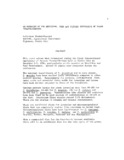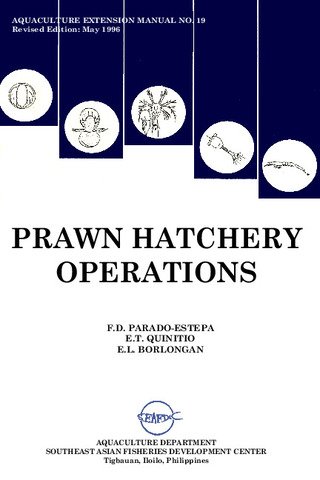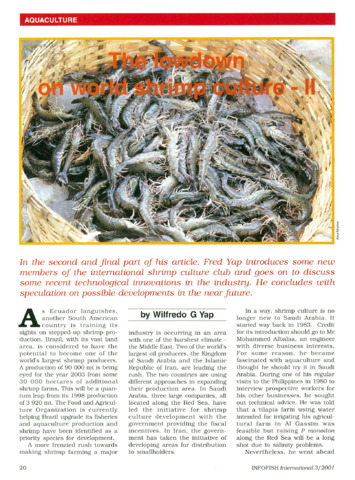Leucaena leucocephala leaves in formulated feed for Penaeus monodon: a concrete example of the application of histology in nutrition research
- Global styles
- MLA
- Vancouver
- Elsevier - Harvard
- APA
- Help

View/
Date
1986Page views
2,359ASFA keyword
AGROVOC keyword
Taxonomic term
Metadata
Show full item record
Share
Abstract
Penaeus monodon postlarvae were fed with formulated diets containing either soaked or unsoaked Leucaena leaves. A similarly prepared feed with soybean in place of Leucaena was used for comparison. Results were analysed by statistical and histological methods.
Results of the 4-week feeding experiment showed that mean weight gains and percentage survival of the prawns fed with the two Leucaena-containing diets were higher, but not significantly different from soybean-containing diet. The content of the poisonous amino acid mimosine in the Leucaena leaves could be reduced about 70% by soaking the leaves in freshwater for 24 h. Highest weight gain was obtained with the feed containing these soaked leaves.
In addition to growth and survival, the R-cells of the midgut glands of the postlarvae were investigated by light and electron microscopy. Although the statistical growth values and the proximate analyses of the test diets were similar, a food-specific ultrastructure was established after only 4 days of feeding. All diets resulted in subcellular characteristics typical for well fed prawns and, at that time, the Leucaena diets were already slightly superior to the soybean control. This indicates that different sources of macronutrients lead to different ultrastructures even if the proximate analyses of protein, carbohydrate and lipid are similar.
Only slight changes in the R-cells were observed after 11, 20 and 28 days in the prawns fed with the soybean diet compared to 4 days of feeding. In the diet containing unsoaked Leucaena leaves, however, many R-cells became heavily damaged after 20 and 28 days, whereas the prawns fed with the diet containing soaked leaves exhibited less pronounced distortion. Statistical analyses of growth and survival rate did not show these adverse effects at that time. Although it is highly probable that the mimosine is responsible for those pathological symptoms, complementary experiments could not clearly prove that.
The effects of feed components are visible on the cellular or organ level after only a few days, whereas the individuals (organism level) reflect them about 10 days later. Another 10 days later the changes are manifested in the population. Therefore it is suggested to use histology in nutrition studies as a supplementary source of information to statistical and biochemical parameters. The midgut glands can further be used to monitor the nutritional condition of prawns in aquaculture, sea ranching, and in ecological investigations.
The study confirms that Leucaena leaves are a promising protein source for prawn diets if mimosine could be reduced to a very low level. A mimosine level of 0.25% in the feed is still too high, if the diet is used uninterruptedly for several weeks.
Description
Contribution No. 187 of the Aquaculture Department of SEAFDEC.
Suggested Citation
Vogt, G., Quinitio, E. T., & Pascual, F. P. (1986). Leucaena leucocephala leaves in formulated feed for Penaeus monodon: a concrete example of the application of histology in nutrition research. Aquaculture , 59(3-4), 209-234. https://doi.org/10.1016/0044-8486(86)90005-0
Type
ArticleISSN
0044-8486Collections
- Journal Articles [1258]
Related items
Showing items related by title, author, creator and subject.
-
An overview of the nutrition, feed and feeding techniques of prawn penaeid/shrimps
Piedad-Pascual, Felicitas (Philippine Council for Aquatic and Marine Research and Development, 1989)This paper echoes what transpired during the first International Conference of Penaeid Prawns/Shrimps held in Iloilo City in December 4-7, 1984, particularly on the Nutrition nd Feed Development. Around 25 papers were ... -
Series: Aquaculture extension manual; No. 19
Prawn hatchery operations
Parado-Estepa, Fe D.; Quinitio, Emilia T. ; Borlongan, Emeterio L. (Aquaculture Department, Southeast Asian Fisheries Development Center, 1996-05)
The manual, an updated version of the 1984 SEAFDEC/AQD manual, presents the underlying principles and step-by-step instructions of prawn larval and post-larval rearing. The techniques described are not only applicable to ...
; Borlongan, Emeterio L. (Aquaculture Department, Southeast Asian Fisheries Development Center, 1996-05)
The manual, an updated version of the 1984 SEAFDEC/AQD manual, presents the underlying principles and step-by-step instructions of prawn larval and post-larval rearing. The techniques described are not only applicable to ... -
The lowdown on world shrimp culture - II
Yap, Wilfredo G. (INFOFISH, 2001)This paper introduces some new members of the international shrimp culture club and goes on to discuss some recent technological innovations in the industry, particularly the polyculture of tilapia (mainly Oreochromis ...





